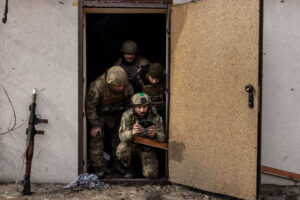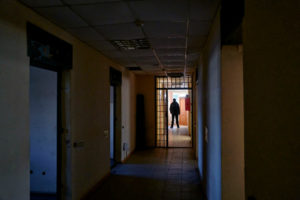However you try to spin it, the drone strikes that struck Moscow’s wealthiest neighbourhoods on Tuesday night represented a grim turning point in Putin’s flagging campaign against Ukraine. The surprise attacks — which killed eight people, and for which Kyiv has denied all responsibility — were the first against Russian civilians since the war began. They were also the most significant incursion into Russian territory since the Second World War.
Putin was quick to brand the strikes a “terrorist” act, while a rattled Yevgeny Prigozhin, head of the Wagner mercenaries, gave war chiefs a dressing-down for their inability to prevent three of eight drones from evading Russian air defences. Yet while this all provided a morale boost for the Ukrainian war effort, the question of retaliation hangs in the air.
Fifteen months into the war, Putin’s bombs have not broken Ukraine. An influx of 300,000 new soldiers over the winter has done little to improve the fighting of Russian units, and the reported deployment of tanks from the Fifties has added fuel to the rumour that Russian munitions are running out. Indeed, Russian military commanders appear to have exhausted their ability to effectively respond to Ukrainian escalation. It is becoming clear, in my view, that the only way Russia can meet escalation with escalation is by introducing nuclear weapons.
Many Western experts say they take the threat of a Russian nuclear strike in Ukraine seriously, but make the mistake of asserting that the odds are low. Last month, for instance, Avril Haines, the US Director of National Intelligence, told a Senate hearing that Putin’s weakened conventional force would make the Russian President more reliant on “asymmetric options” for deterrence, including nuclear capabilities — but he also said it was “very unlikely” that Moscow would do so. Speaking at the same hearing, the director of the Defense Intelligence Agency, Lieutenant General Scott Berrier, also assessed the chances as “unlikely”.
And yet, there is strong evidence that Putin has resolved to use a tactical nuclear weapon in his war in Ukraine. In recent speeches and interviews, he has argued that Russia faces an existential threat — a situation, under Russian policy, that warrants the use of nuclear weapons. He has also reshuffled his military leadership, so that the three generals responsible for the employment of tactical nuclear weapons now command his “special military operation” in Ukraine.
Moreover, while Nato has made it clear that it will not sanction the use of its members’ nuclear weapons to defend Ukraine, Putin already has tactical reasons to deploy them: to save Russian soldiers’ lives, to shorten the war, to destroy Ukrainian forces. He also has strategic reasons: to rejuvenate the deterrent value of his nuclear arsenal and to prove that he is not a bluffer. We must therefore assume he is ready to use them, most likely in response to his faltering military’s inability to sufficiently escalate by conventional means. In other words, the nuclear genie is out of the bottle.
For much of the last 80 years, Russia’s security has rested on two pillars whose relative strength has waxed and waned — its conventional ground forces and its nuclear weapons. The conventional forces have been used to influence, bully and force Russia’s neighbours and adversaries to bend to its will. The nuclear forces were intended to deter the United States and the West from interfering militarily in Russia and its perceived zone of influence. Since the end of the Cold War, however, Russia’s conventional forces have at times struggled with their share of the task. To compensate, Russian leaders have had to rely on their nuclear forces to do both: strategic nuclear weapons to deter the West and tactical nuclear weapons to threaten neighbours.
Today, a single nuclear strike in Ukraine could thwart a Ukrainian counterattack with little loss of Russian lives. For Moscow, this consideration is as much practical as it is moral: last year’s large-scale mobilisation and increase in military units showed that Putin’s army was too small for its task. Nevertheless, Russia has managed to create only a few new battalions because most new personnel and equipment simply replaced losses in existing units. Putin and his military leaders are running out of the people and material needed to achieve his goals.
At the start of this year, Putin took several public steps to demonstrate that he is not bluffing about using nuclear weapons. In February, he signed a law “suspending” Russia’s participation in New Start, the strategic nuclear arms treaty. This step officially ended joint inspections of American and Russian nuclear weapons sites and released Russia from the obligation to limit its number of strategic nuclear weapons — though Russia promised to do so.
Then, in March, Putin announced that he would station tactical nuclear weapons in Belarus, with a storage facility set to be built as early as July. Since Russia has already deployed nuclear-capable Iskander missile systems there — as well as thousands of troops — this would put nuclear delivery systems and warheads in close proximity to one another, greatly reducing the warning time of their use. Putin also suggested that Belarussian forces would be trained to use the weapons.
The Kremlin has taken these increasingly threatening steps in the belief that Nato and the West — in particular, the United States — is not paying attention to Russian demands on the global stage. In 2018, when Putin unveiled a bevy of new nuclear weapons, he warned: “You will listen to us now!” Except many didn’t: four years later, his invasion of Ukraine was a wake-up call for those who had ignored him.
Despite this, some in Russia undoubtedly fear that the threat of a nuclear strike has begun to ring hollow. And for Putin, whose regime is vulnerable, to threaten a tactical nuclear attack without following through now carries perhaps as much risk as striking. As a result, besides warning the West that he might use a nuclear weapon, the Kremlin has, step by step, prepared the Russian people with reasons why he should use nuclear weapons. Among these justifications, Putin has repeatedly invoked “whataboutist” comparisons to the United States. When announcing plans for deployment of Russian nuclear weapons to Belarus, he said: “The United States has been doing this for decades. They have long… deployed their tactical nuclear weapons on the territory of their allied countries, Nato countries, in Europe, in six states… We are going to do the same thing.” Putin has also repeatedly referenced American nuclear strikes on Hiroshima and Nagasaki and equated American goals then — to save soldiers’ lives and shorten the war — with Russian goals today.
He has, for instance, made clear to the Russian people that Moscow’s red lines for the use of nuclear weapons, spelled out in its official documents, have all been crossed since the invasion. These include the claim that the very survival of Russia is at stake in the current struggle — and at last month’s Victory Day parade, Putin declared that the West’s “goal is to achieve the collapse and destruction of our country”. Another of Russia’s officially designated red lines is attacks “against critical governmental or military sites of the Russian Federation, disruption of which would undermine nuclear forces’ response actions”. Perhaps in light of this, Moscow has alleged that Ukrainian drones have struck strategic nuclear bomber planes inside Russia, and that Ukraine and the US are responsible for drones launched to assassinate Putin. All these claims, the real and the fabricated, are used to establish the pretext for Putin to use nuclear weapons.
In response, a number of Western observers have pointed out that, since we have not seen any movement of nuclear weapons, we have no tangible signs of intent to use them. I disagree. Last autumn, officials in Kyiv reported that Russia was firing “Kh-55 nuclear cruise missiles” with dummy warheads. Observers suggested these missiles — which are designed to carry only a nuclear weapon — were launched to erode Ukrainian air defences by “decoying” them into destroying the Kh-55s rather than missiles with conventional explosives. This claim makes little sense: missiles, even unarmed, would be too valuable for Russia to use as decoys. What does make sense, however, is launching Cold War-era missiles with dummy warheads to test their reliability for use in a real nuclear strike.
But what will trigger Putin’s decision to launch? Most likely it will be the inability of the Russian military to meet his demands by conventional means. If a Ukrainian offensive threatens, for example, the loss of Crimea, Putin would seek an escalation of the fighting to prevent that loss. If the conventional forces could not successfully respond, a nuclear strike against the Ukrainian forces would be deployed. As he announced last September, on the night he illegally added four Ukrainian provinces to Russia: “If the territorial unity of our country is threatened, in order to protect Russia and our nation, we will unquestionably use all the weapons we have. This is no bluff.”
At home, too, there are push factors that may further embolden Putin. Most urgently, he is under pressure from Russian nationalists, who supported him in his rise to power, but are now vocal in their dissatisfaction. Some, like former FSB officer Igor Girkin, have openly criticised the senior military leadership, even Putin. That criticism may be morphing into opposition, forcing him to consider escalating his war before his conventional forces are ready.
Meanwhile, claims that Putin would be dissuaded from using nuclear weapons by important allies, such as China or India, are not borne out by the war thus far. Although Putin values the support of others, he has not shied away from putting that support at risk to get what he wants.
None of this is to say that we in the West should pressure Ukraine to forgo its goal to liberate all seized territory. But it does mean that we should anticipate a nuclear attack and develop possible responses. As soon as Russia uses a nuclear weapon in Ukraine, the fallout will start to spread. Tens of thousands of Ukrainians will be dead, suffering or dealing with the effects of the explosion. Hundreds of millions of Europeans will be bracing for war. But 7 billion others around the globe will go about their business, alarmed but physically unaffected.
Ultimately, this may prove more dangerous to the international order. The image that many people have of nuclear arms as civilisation-ending weapons will be erased. In its place, such weapons will have been “normalised” and, although tragic, acceptable in war. In this dramatically changed world, the burden is on the West to decide how to respond.
A version of this article first appeared on RussiaMatters.
Disclaimer
Some of the posts we share are controversial and we do not necessarily agree with them in the whole extend. Sometimes we agree with the content or part of it but we do not agree with the narration or language. Nevertheless we find them somehow interesting, valuable and/or informative or we share them, because we strongly believe in freedom of speech, free press and journalism. We strongly encourage you to have a critical approach to all the content, do your own research and analysis to build your own opinion.
We would be glad to have your feedback.
Source: UnHerd Read the original article here: https://unherd.com/




